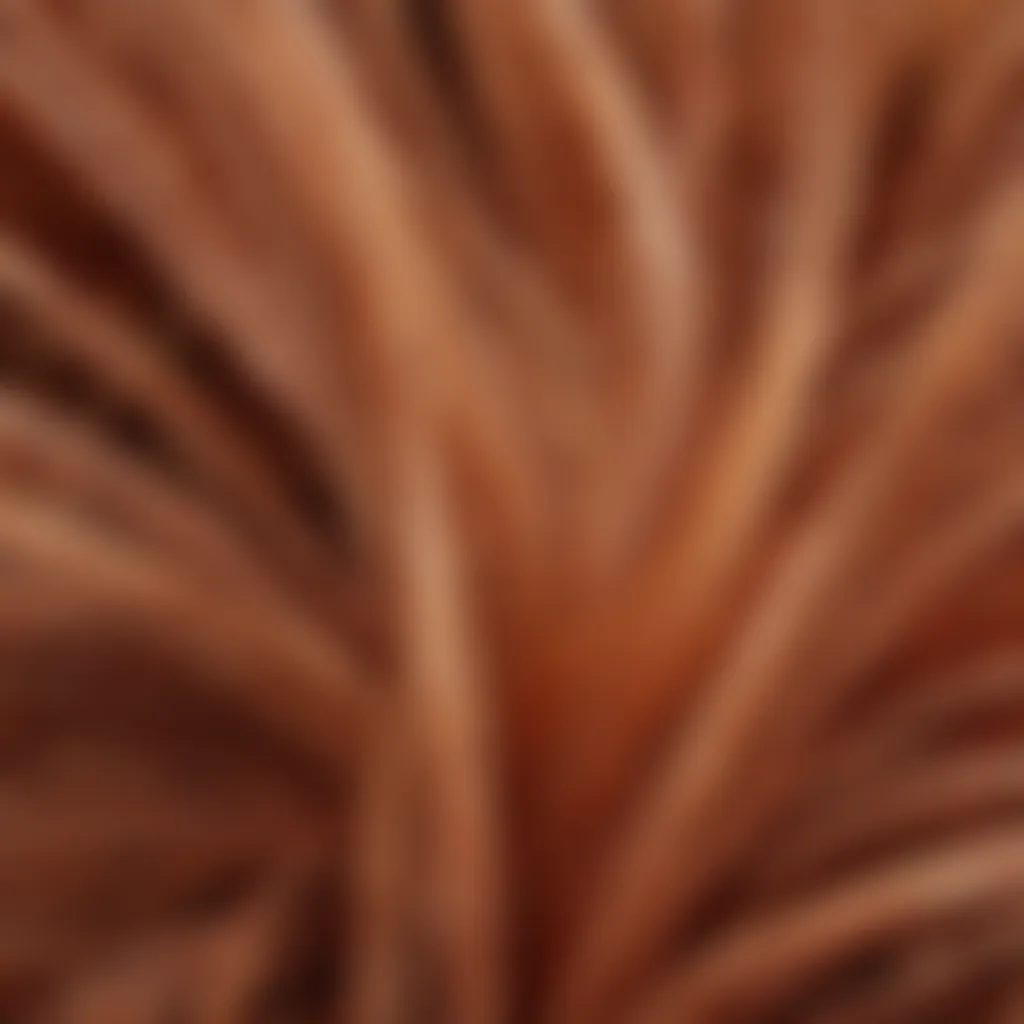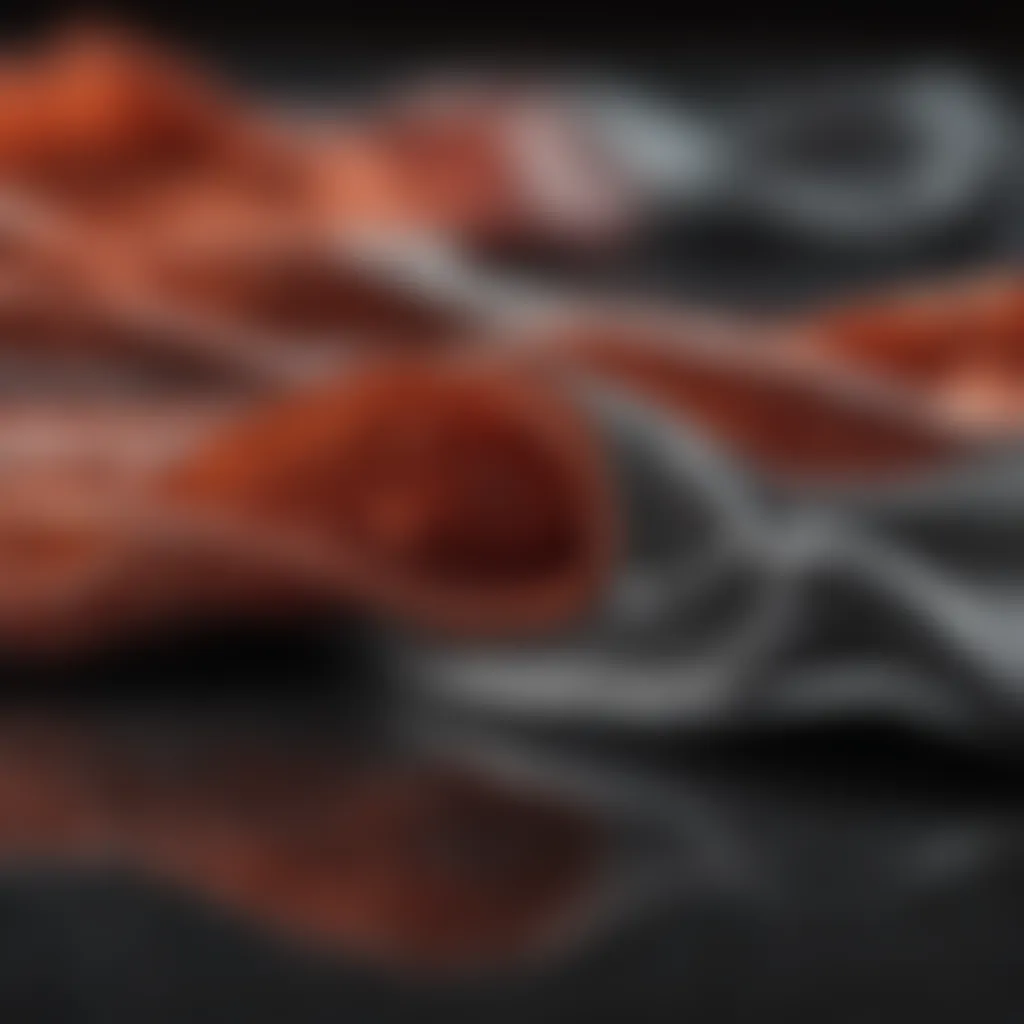Exploring Nanoscale Cloths: Trends and Applications


Intro
The exploration of nanoscale cloths has opened new avenues in the textile industry. This innovation offers remarkable properties and potential applications that cater to various sectors. This article examines the current market on Amazon, revealing trends and future directions in nanoscale textile technology.
Nanoscale cloths possess unique characteristics due to their diminutive structure. They often enhance durability, provide water resistance, and offer antimicrobial properties. Their enticing attributes make them valuable in fields ranging from healthcare to fashion. Thus, businesses and consumers alike are investing attention in this rapid development.
As one navigates through the offerings on Amazon, it is crucial to identify practical applications of these textiles. This article will sift through the most common uses, including their roles in personal protective equipment and sportswear. We will also consider their effects on everyday life, highlighting how these materials can streamline daily activities.
Not only does scientific research underpin these developments, but market trends also indicate a shift towards eco-friendly and functional textiles. The integration of technology in fabric production is undeniably reshaping consumer expectations and advancing market offerings.
Overall, the aim here is to create an informative guide. Our journey will encompass the essential components of nanoscale cloths, delving deep into their properties, highlighting applications, and projecting future directions in the ever-evolving textile landscape.
Prolusion to Nanoscale Cloth
The importance of nanoscale cloth lies in its potential to revolutionize textiles with unique properties that enhance everyday products. This section will delve into the fundamental aspects of nanoscale cloth, such as its definition, relevant characteristics, and the historical context behind its development. Understanding the beginnings and framework of nanoscale textiles helps to appreciate their current applications and future possibilities.
Definition and Characteristics
Nanoscale cloth refers to fabrics that have been engineered at the nanoscale, often involving fibers or materials with dimensions typically less than 100 nanometers. This manipulation changes their physical and chemical properties, leading to advantageous features not present in conventional textiles. The most notable characteristics include increased strength, durability, and resistance to stains or bacteria. These enhanced materials have myriad applications, making them relevant across various sectors, including medical, industrial, and consumer products.
Some key characteristics of nanoscale cloth include:
- Improved strength-to-weight ratio: Fabrics can be lighter yet stronger.
- Hydrophobic and oleophobic properties: These allow for easy cleaning and protection from stains.
- Antimicrobial capabilities: This property is vital for medical and hygiene applications.
History of Nanofabrication Techniques
The history of nanofabrication in textiles is marked by significant advancements in technology and materials science. The roots trace back to the early 2000s, when researchers began to explore the possibilities of manipulating materials at the molecular level. Techniques such as electrospinning, which produces fine fibers, and chemical vapor deposition, which helps create films at the nanoscale, have played a critical role in this evolution.
As research progressed, various techniques emerged, each with unique advantages and challenges. This journey is vital to understand the developments that contribute to the current state of nanoscale cloth. Furthermore, it highlights the ongoing exploration and need for innovations in this field, promising a future with even more transformative applications.
The Science of Nanoscale Textiles
Understanding nanoscale textiles is key for exploring their applications and implications in various sectors. The field of nanoscale textiles combines advanced science and technology to create materials with unique properties. These characteristics are becoming increasingly relevant in many industries, from fashion to medicine. This section discusses the role of nanostructures and the fabrication methods used to create these textiles.
Nanostructures and Their Properties
Nanoscale structures are defined by their size, usually ranging from 1 to 100 nanometers. This small scale allows for remarkable properties that differ from bulk materials. For instance, when materials are made at the nanoscale, they can exhibit enhanced mechanical strength, improved flexibility, and unique optical characteristics. These attributes are significant for creating textiles that can respond to various environmental stimuli.
Nanoscale textiles can also possess antibacterial properties. This is particularly important in the healthcare sector, where hygiene is a critical concern. By integrating nanostructures into fabrics, manufacturers can reduce the growth of harmful bacteria, leading to safer medical applications and textiles with improved durability in everyday use.
Fabrication Methods
The methods used to fabricate nanoscale textiles play a pivotal role in defining their characteristics. Different techniques yield distinct properties and applications.
Electrospinning
Electrospinning is a popular method for producing nanoscale fibers. This process involves applying a high voltage to a polymer solution to create a fine filament. The key characteristic of electrospinning is its ability to produce continuous fibers at the nanoscale efficiently. The fine fibers created can be used in various applications, such as filtration and medical dressings.


One unique feature of electrospinning is its versatility. This method can be used with various polymers, allowing for the tailoring of properties for specific applications. However, it does come with challenges, such as the need for specialized equipment and expertise in handling chemicals.
Chemical Vapor Deposition
Chemical Vapor Deposition (CVD) is another key method for creating nanoscale textiles. It involves depositing thin films of materials onto a substrate through chemical reactions in vapor form. The significant advantage of CVD is its ability to produce high-purity and conformal coatings on various surfaces.
This method is particularly beneficial for producing textiles with specific properties like hydrophobicity or electro-conductivity. However, CVD's costs and equipment requirements can limit its accessibility for some manufacturers.
3D Printing
3D printing is revolutionizing the production of nanoscale textiles. Unlike traditional methods, 3D printing allows for the precise control of material layering, enabling complex designs. A notable advantage of this technique is its adaptability. Producers can create custom sizes and shapes that suit a variety of applications, from fashion to functional wear.
However, the technology is still evolving. While it shows great potential, the speed of production and material limitations can pose challenges for widespread adoption.
Applications of Nanoscale Cloth
Nanoscale cloth exhibits a variety of applications that extend across diverse sectors. Understanding these applications provides a perspective on how innovations at the nanoscale can reshape everyday materials. The medical field, industrial settings, and consumer products benefit significantly from the unique properties that nanoscale textiles offer. Their inherent characteristics, such as increased strength, durability, and the capability to incorporate functional properties, make them crucial for various uses. This section discusses three primary areas where nanoscale cloth proves invaluable, emphasizing their contributions within specific contexts.
Medical Applications
The healthcare sector has seen remarkable enhancements with the introduction of nanoscale textiles. These advanced fabrics promote better patient outcomes and enhance the functionality of medical devices.
Antibacterial Textiles
Antibacterial textiles have gained attention for their ability to combat infections. These fabrics are engineered to reduce bacterial growth, making them suitable for use in medical apparel and hospital environments. The key characteristic of antibacterial textiles is their incorporation of silver nanoparticles, which provide effective antimicrobial action. This is a significant benefit in a medical setting, where hygiene is paramount.
The unique feature of such textiles is their long-lasting effectiveness. They are less prone to washing out, leading to durable performance over time. However, there is a concern regarding possible skin sensitivities. Careful formulation is essential to prevent adverse effects. Overall, antibacterial textiles are a vital advancement in enhancing hygiene and reducing infection risks in medical practices.
Smart Bandages
Smart bandages represent another exciting application of nanoscale cloth in medicine. They are designed to monitor wounds and deliver medication in a controlled manner. The key characteristic of smart bandages is their integration of sensors that track vital signs, moisture levels, and temperature through nanoscale technology. This capability allows for real-time data collection, enabling prompt medical responses.
The advantage of employing smart bandages lies in their ability to promote faster healing by providing optimal conditions for recovery. However, they may come with higher costs due to their advanced technology. Balancing functionality and affordability is critical for broader adoption in medical settings.
Industrial Applications
The industrial sector utilizes nanoscale fabrics for enhancing safety and efficiency. Protective wear and filtration systems are two significant applications that showcase these advancements.
Protective Wear
Protective wear developed with nanoscale technology is designed to offer enhanced safety features. Such garments exhibit improved resistance to abrasions, cuts, and chemicals. The key characteristic of protective wear is its lightweight nature due to nano-engineering, which ensures comfort while maintaining protection. This makes them a favorable choice among professionals who require safety without sacrificing mobility.
An essential feature of protective clothing is moisture-wicking properties. This function helps keep the wearer dry during demanding tasks. However, the cost of these garments can be higher than traditional protective wear, which may deter some users. Balancing cost with safety is an ongoing challenge in the industry.
Filtration Systems
Nanoscale cloth is also prominent in filtration systems, particularly in air and water purification technologies. These filters leverage their increased surface area and pore structure, making them far more effective than conventional materials. The key characteristic of these filtration systems is their ability to trap nanoparticles and pathogens, thus providing superior filtration.
A distinctive advantage of using nanoscale fabrics in filtration is their longevity and efficiency, which can lead to reduced replacement frequency. However, the manufacture of such materials can be resource-intensive, raising sustainability concerns. Addressing these environmental issues is vital for the future of filtration technology.


Consumer Products Available on Amazon
Retail platforms, such as Amazon, offer a variety of consumer products utilizing nanoscale cloth. These accessible items bring advanced textile technology directly to consumers.
Nanoscale Athletic Gear
Nanoscale athletic gear showcases the innovative use of nanoscale materials to enhance athletic performance. The primary characteristic of these products is their ability to repel moisture and improve breathability. This makes them a popular choice for athletes seeking comfort during intense activities.
An advantage of nanoscale athletic gear is its lightweight, flexible nature, which allows for unrestricted movement. However, some users may find that these products come at a premium price point. The investment could yield significant performance enhancements for serious athletes, making it worthwhile.
Home Textiles with Nanotechnology
Home textiles incorporating nanotechnology provide unique features that enhance everyday living. These products often include stain-resistant and wrinkle-free capabilities, appealing to many consumers. The key characteristic of these textiles is their easy maintenance, allowing for a more convenient lifestyle.
The unique selling point of home textiles is their durability under various conditions, which can be beneficial for busy households. However, there might be concerns regarding the potential environmental impact of nanotechnology in textiles. Consumers are increasingly interested in sustainable choices, prompting ongoing discussions in the industry.
In summary, the applications of nanoscale cloth span medical, industrial, and consumer domains, each demonstrating the significant potential of these materials. Various factors, including cost, effectiveness, and environmental considerations, must be considered for successful integration into everyday items.
Market Trends and Analysis
The examination of market trends and analysis is critical to understanding the evolving landscape of nanoscale cloth. The adoption of such textiles impacts various sectors, including health care, industry, and consumer goods. Several factors drive this change, making it essential to evaluate the current climate and future forecasts.
Current Market Landscape
The market for nanoscale textiles is characterized by rapid advancements and a shift in consumer preferences. According to recent studies, interest in functional fabrics is on the rise, as more buyers recognize the benefits of materials that enhance performance. For instance, durability, comfort, and specific functionalities such as breathability and antibacterial properties are increasingly appealing to consumers.
Several companies have been quick to capitalize on these trends. Large retailers like Amazon offer a diverse range of nanoscale textiles, from athletic gear designed for performance to innovative home textiles aimed at improving safety and convenience. The rise of eco-conscious consumers has also nudged manufacturers towards sustainable practices, further influencing market dynamics.
Some notable features of the current landscape include:
- Increased investment in research and development for novel textile solutions.
- Collaborations between textile companies and tech startups to develop smarter fabrics.
- A growing emphasis on sustainability in product offerings, reflecting a global trend towards environmentally friendly materials.
Overall, the current market landscape for nanoscale cloth shows a blend of technological innovation and responsiveness to consumer demand.
Growth Projections for Nanoscale Textiles
Looking ahead, the growth projections for nanoscale textiles suggest a robust expansion. Market analysts predict a compound annual growth rate surpassing 20% over the next five years. Such growth may be fueled by the increasing integration of nanotechnology in various applications, including medical supplies that improve health outcomes and protective gear for industrial workers.
Key factors contributing to this anticipated growth include:
- Technological advancements that facilitate more efficient manufacturing processes, reducing costs.
- Expanding applications in emerging sectors such as smart textiles, which combine textiles with technology for enhanced functionality.
- Growing awareness about the health benefits of using nanoscale materials
Potential challenges could arise from regulatory hurdles as governments seek to establish guidelines surrounding the use of nanomaterials. However, the overall sentiment toward future growth remains positive.
Challenges in Nanoscale Fabrication
The development of nanoscale cloths poses significant challenges that can influence their widespread adoption and effectiveness. Understanding these challenges is important because it sheds light on both the complexities of nanofabrication and the implications for consumers and industries alike. Two main categories of challenges are crucial for consideration: cost implications and sustainability issues.
Cost Considerations


When examining the fabrication of nanoscale textiles, cost is often a decisive factor. The advanced technologies required for such materials, like electrospinning and chemical vapor deposition, involve considerable investments in equipment and materials. For instance, the production of high-quality nanofibers demands precision and control that increase operational costs.
Moreover, scaling up production for commercial viability can amplify expenses. Smaller manufacturers might find it difficult to compete with larger companies that can spread costs over higher production volumes. This discrepancy can lead to higher prices for innovative products, which may not always appeal to cost-sensitive consumers.
Here are some specific cost-related challenges:
- Research and Development: Significant funding is required to explore new methods and improve existing techniques.
- Material Costs: The raw materials suitable for nanoscale fabrication can be expensive, impacting the final product price.
- Labor Costs: Special skills are required for handling nanofabrication processes, leading to increased labor expenses.
Efforts to mitigate these costs must be explored, including government grants for research and incentives for sustainable practices.
Sustainability Issues
Sustainability in materials development is becoming increasingly critical. Nanoscale textiles often involve synthetic fibers, which may not be biodegradable. This raises serious environmental concerns. Creating materials that adhere to sustainability principles is vital for the longevity and acceptance of nanoscale textiles in the market.
Issues include:
- Waste Generation: The processes used in nanofabrication can produce waste that may not be easily recyclable or safe for disposal.
- Production Footprint: The energy-intensive processes can contribute to a larger carbon footprint, especially if fossil fuels are the main energy source.
- Toxicity: Some nanomaterials have shown potential hazards, raising questions about their safety for both manufacturers and consumers.
Addressing sustainability requires a concerted effort. This can include developing biodegradable nanofibers, using renewable sources for energy, and establishing stringent guidelines for safe production practices.
"The future of nanoscale fabrics can only be bright if we address the cost and sustainability challenges today."
Balancing these concerns is essential for ensuring that the benefits of nanoscale textiles reach consumers without compromising environmental standards.
Future Directions in Nanotechnology
The exploration of nanoscale cloth is not merely a passing trend; it represents a significant evolution within textile science. Understanding future directions in nanotechnology is critical for stakeholders, including consumers, manufacturers, and policymakers. As we delve into this realm, it becomes clear that innovations can lead to enhanced product functionalities, better sustainability, and overall improvements in user experience.
Innovations on the Horizon
The potential for future innovations in nanoscale textiles is expansive. Several areas stand out:
- Smart Textiles: These products will incorporate sensors that monitor various parameters, such as temperature or moisture levels. For example, jeans embedded with temperature-regulating nanomaterials can provide comfort across different climates.
- Self-Cleaning Fabrics: Utilizing surfaces that repel dirt and stains, these textiles could drastically reduce the need for washing, conserving water and energy. Self-cleaning capabilities derived from nanotechnology can redefine maintenance protocols.
- Advanced Anti-Microbial Solutions: The integration of nanomaterials known for their antibacterial properties can create textiles that are safer for use in healthcare and daily life, decreasing the risk of infections.
- Enhanced Durability: Fabrics strengthened at the molecular level can resist wear and tear, extending the life cycle of products.
"Innovations in nanotechnology will redefine how we perceive textiles, enhancing their utility and performance."
Potential Regulatory Considerations
As the field progresses, regulatory frameworks must evolve to keep pace. Addressing potential risks associated with nanoscale materials is paramount. Key considerations include:
- Safety Testing Protocols: Establishing comprehensive testing guidelines for the safety of nanomaterials in textiles is essential. This includes evaluating potential skin reactions and environmental impacts.
- Standardization: A standardized approach to labeling nanoscale products will help consumers make informed choices. Regulators need to define the terminology associated with nanotechnology clearly.
- Environmental Impact Assessments: It is crucial to assess how the production and disposal of nanoscale materials affect ecosystems. Regulatory bodies must require manufacturers to demonstrate environmentally responsible practices.
As the landscape of nanoscale textiles continues to evolve, it requires careful consideration from a regulatory perspective. Only through comprehensive oversight can we ensure that the benefits associated with these innovations do not come at an unforeseen cost to health or the environment.
The End: The Future of Nanoscale Cloth
As we look ahead, the implications of nanoscale cloth technology hold both promise and challenges. The unique properties of these textiles make them suitable for many applications, from enhancing medical devices to creating high-performance athletic wear. Understanding these materials is crucial not just for innovators but also for consumers who wish to integrate advanced textiles into their daily lives.
One significant aspect to mention is the sustainable aspect of nanoscale fabrics. Many manufacturers aim to develop eco-friendly alternatives. This shift is not only necessary for the environment but also appealing to consumers who are becoming more conscious about their purchasing decisions. Innovative companies are likely to focus on reducing waste in the manufacturing processes while ensuring that the end products are durable and functional.
Moreover, future regulations and standards will play a vital role in the growth of the nanoscale cloth market. As the technology evolves, it is essential that safety and ethical considerations are prioritized. This includes understanding the potential implications of nanoparticles on human health and the environment. It is equally critical to ensure that advancements do not come at the expense of consumer safety.
"The advancement of nanoscale textiles offers pathways to revolutionize various industries but requires a cautious approach to ensure safety and sustainability."
In addition to regulatory frameworks, ongoing research will dictate the future trajectory of these textiles. Collaborations between academic institutions and industry players will be essential in exploring new applications and refining existing technologies. As the public begins to accept these materials more, wider adoption will lead to increased innovation and market offerings.







